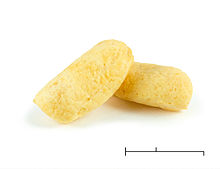 Two amplang from Kotabaru; scale bar shows 1 cm / 1″ Two amplang from Kotabaru; scale bar shows 1 cm / 1″ | |
| Type | Snack |
|---|---|
| Place of origin | Indonesia |
| Region or state | Samarinda and Balikpapan in East Kalimantan |
| Associated cuisine | Indonesia and Malaysian (especially in Sabah) |
| Main ingredients | Wahoo or Spanish mackerel, tapioca flour, selected spices |
Amplang, also known as kerupuk kuku macan, is an Indonesian traditional savoury fish cracker snack commonly found in Indonesia and Malaysia. Amplang crackers are commonly made of ikan tenggiri (wahoo) or any type of Spanish mackerel, mixed with starch and other materials before being deep-fried.
The shape and size of amplang might vary, from traditional elongated "tiger nails" to dice or ping-pong balls. The colour may range from yellow to light brown.
History

In Indonesia, amplang is traditionally associated with Samarinda, the capital city of East Kalimantan, since the amplang cracker home industry has thrived in the city since the 1970s. Traditionally, amplang was made from ikan pipih or ikan belida (Chitala lopis). However, since this freshwater fish had become scarce, amplang makers replaced them with ikan tenggiri (wahoo) or gabus (striped snakehead). From Samarinda, the popularity of this savoury fish cracker spread to other cities in the Borneo island, such as Balikpapan, Banjarmasin, Pontianak, and even to the neighbouring Sabah in Malaysia.
Amplang is often sought as oleh-oleh (foodstuff gift or souvenir) by those who visited East Kalimantan. Today, amplang made by home industries in Kalimantan has been widely distributed, available in marketplaces and supermarkets in Indonesian cities, such as Jakarta, Bandung, Surabaya, and Medan.
Production centres
Amplang is commonly produced by home industries in Samarinda, East Kalimantan in Indonesia. Other than Samarinda, amplang production centres also can be found in Balikpapan, Pontianak in West Kalimantan and Banjarmasin in South Kalimantan.
In neighbouring Malaysia, amplang is mainly produced on the east coast of Sabah, particularly in the town of Tawau.
Variants
Today, the makers of amplang in East Kalimantan produce the snack not only with a fish flavor, but in a variety of flavors such as crab and seaweed. Nevertheless, the original amplang kuku macan remains the most popular.
See also
References
- ^ "Amplang Chips". Indonesia Wonder. 13 January 2012. Archived from the original on 19 August 2014. Retrieved 18 August 2014.
- Nevrianto Hardi Prasetyo (5 June 2011). "Amplang Makanan Khas Kalimantan". Tribun Kaltim (in Indonesian). Tribun News.com. Retrieved 18 August 2014.
- "Amplang Crackers". Malaysia, Truly Asia. Tourism Malaysia. Archived from the original on 16 August 2014. Retrieved 20 February 2018.
- "Amplang, Renyah Gurih Kerupuk Ikan khas Kalimantan". Indonesia Kaya (in Indonesian). Retrieved 20 February 2018.
- ^ Kartika Eka Hendarwanto (14 October 2013). "6 Oleh-oleh Khas di 'Kota Seribu Sungai' Kalimantan Selatan" (in Indonesian). Liputan 6. Retrieved 18 August 2014.
- Nevrianto Hardi Prasetyo (5 June 2011). "Home Industri Amplang Kaltim". Tribun Kaltim (in Indonesian). Tribun News.com. Archived from the original on 19 August 2014. Retrieved 18 August 2014.
- "Wisata Kuliner Amplang" (in Indonesian). IANN news.com. Archived from the original on 4 March 2016. Retrieved 16 August 2013.
- "Amplang". Department of Fisheries, Malaysia. Archived from the original on 16 August 2014. Retrieved 16 August 2013.
| Common dishes |
| ||||||||||||
|---|---|---|---|---|---|---|---|---|---|---|---|---|---|
| Snacks |
| ||||||||||||
| Desserts | |||||||||||||
| Drinks |
| ||||||||||||
| Condiments | |||||||||||||